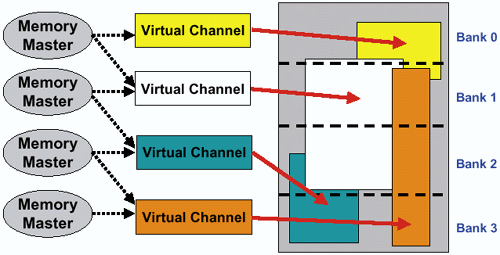Athlon Motherboard Roundup - March 2000
by Anand Lal Shimpi on March 27, 2000 12:27 AM EST- Posted in
- Motherboards
Just like most of the other options, the memory support of an Athlon motherboard depends on the chipset the particular board is using.
The AMD 751 North Bridge, which is part of the AMD 750 chipset, has very limited memory support for PC100 SDRAM only. This is, unfortunately, a shortcoming of the AMD 750 chipset, because, when running at 100MHz in accordance with the PC100 specification, the chipset provides for a total of 800MB/s of bandwidth. With AGP 2X (the maximum supported by the chipset) transferring at a peak of 528MB/s (actually 533MB/s, but who’s counting?), you are left with around 266MB/s of bandwidth left for your processor and the rest of your system to access the system memory with.
This limitation can be seen in the more high end benchmarks since they are generally much more dependent on memory bandwidth than your basic office applications, but as applications and tasks become more and more complex, the limitation will be seen in an increasing number of situations.
The VIA KX133 chipset aims to remedy this situation by providing support for a total of four memory types, three of which claim to offer bandwidth improvements over the sole PC100 SDRAM support of the AMD 750 chipset.
The memory controller integrated into VIA’s 371 North Bridge of the KX133 chipset is identical to the memory controller integrated into the 694X North Bridge of the Apollo Pro 133A chipset and thus the specifications are the same. The memory controller supports both PC133 and PC100 SDRAM as well as VC100 and VC133 Virtual Channel SDRAM. The way the chipset goes about supporting more than one clock frequency of the same memory type is by allowing the user to clock their memory at 33MHz faster or 33MHz slower than their FSB frequency or equal to their FSB frequency if they have memory capable of running at that speed.
This allows a user with PC100 memory to run their memory at 100MHz while their FSB operates at 133MHz (133MHz – 33MHz = 100MHz), while a user with PC133 memory can run their memory at 133MHz even if their FSB is only running at 100MHz. There are obviously more combinations than this alone, but it is up to the motherboard manufacturer to make sure that support for these combinations is provided for.
Ideally, motherboard manufacturers should allow a user to set his/her memory bus equal to the FSB, FSB + 33MHz or FSB – 33MHz, regardless of the FSB setting. Theoretically, this would give the user the opportunity to clock their memory at 166MHz while their FSB runs at 133MHz. Unfortunately, we have yet to see any memory capable of reliably operating at this frequency which makes this more of a “wouldn’t that be cool” than a reality.
The Virtual Channel SDRAM support of the chipset is an interesting feature, and although we have just begun to see some places offering VC-SDRAM for sale, the technology in its current form is unlikely to catch on to the point where it justifies going with VC-SDRAM over regular SDRAM. In the future, we may see a Virtual Channel like technology implemented into a DDR SDRAM chip, but until then, the technology is unlikely to catch on.

Our tests have also concluded that the performance of VC-SDRAM isn’t all that it’s cracked up to be. It is barely faster than SDRAM in most situations, and in some cases, it is actually slower than regular PC100 or PC133 SDRAM, something which is most likely the fault of a flawed VC-SDRAM implementation in VIA’s memory controller.
Needless to say (it’s something we can’t say enough), VC-SDRAM isn’t something you should lose sleep over. It’s not something that you’re missing out on, simply because the performance isn’t there. While the technology behind it is definitely interesting, it’s not worth the trouble at this point in time.










0 Comments
View All Comments